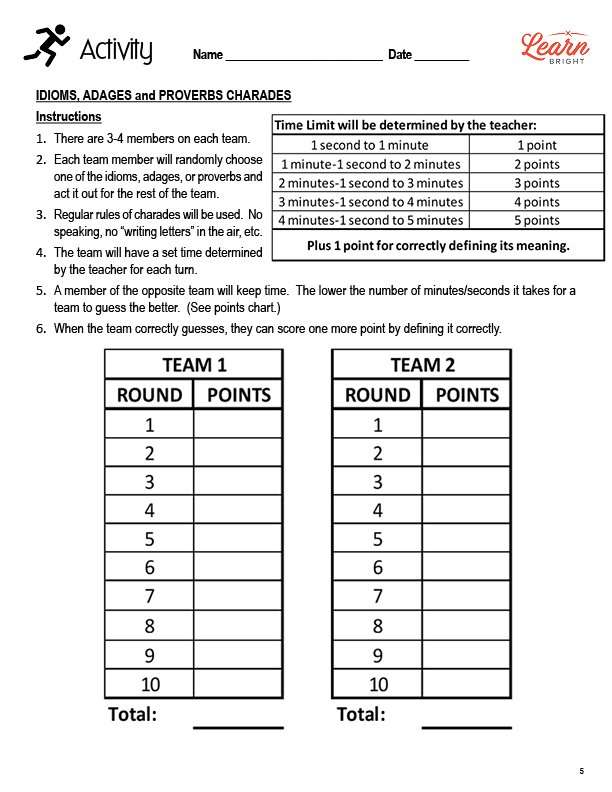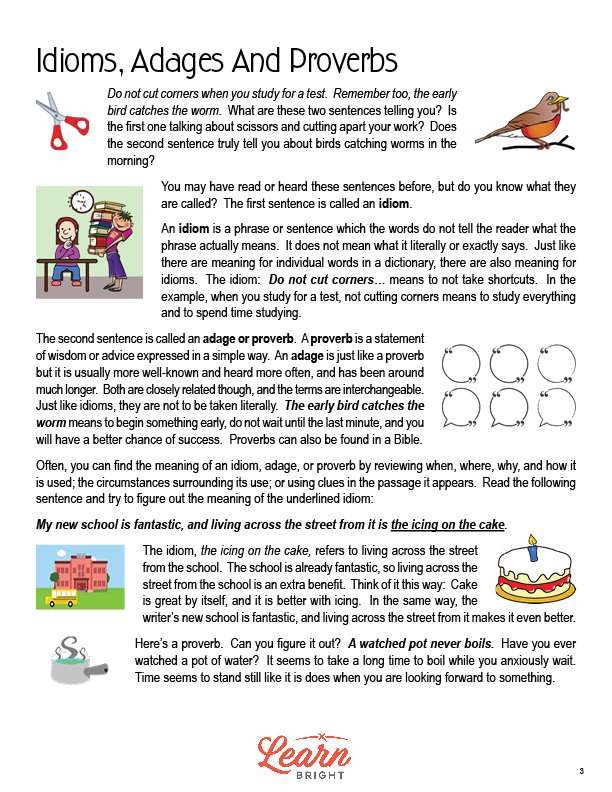Description
What our Idioms, Adages and Proverbs lesson plan includes
Idioms, Adages and Proverbs outlines the differences between idioms, adages, and proverbs. Students will learn what they are, how to define them, and how to recognize them in writing. At the end of the lesson, students will be able to define, identify, and use idioms, adages, and proverbs correctly. This lesson is for students in 4th grade, 5th grade, and 6th grade.
Classroom Procedure
Every lesson plan provides you with a classroom procedure page that outlines a step-by-step guide to follow. You do not have to follow the guide exactly. The guide helps you organize the lesson and details when to hand out worksheets. It also lists information in the orange box that you might find useful. You will find the lesson objectives, state standards, and number of class sessions the lesson should take to complete in this area. In addition, it describes the supplies you will need as well as what and how you need to prepare beforehand. The only supplies you will need for this lesson are the handouts. To prepare for this lesson ahead of time, you can prepare three to five adages and idioms for the lesson opening, copy sets of adages and idioms for the activity, and copy the handouts.
Options for Lesson
Included with this lesson is an “Options for Lesson” section that lists a number of suggestions for activities to add to the lesson or substitutions for the ones already in the lesson. The first several suggestions and additions have to do with the lesson activity, which is a version of charades. The first suggestion is to add additional idioms, adages, and proverbs from outside sources to the game. You can also change the size of the teams for the game if you’d like. You can structure the charades game like a tournament, using additional content. A final adjustment to the activity is to have students play the game using Pictionary rules rather than the rules for charades.
If you’d like to add an additional activity to the lesson, you can have students research other idioms, adages, and proverbs using the internet and present them and their meanings to the class. Finally, you can have your students write a story using a specific number of idioms, adages, and proverbs.
Teacher Notes
The teacher notes page includes a paragraph with additional guidelines and things to think about as you begin to plan your lesson. It notes that while students may be familiar with some idioms, adages and proverbs, they likely don’t understand the significance of them. However, it is important that they learn because they often come up in reading material and in other places. This page also includes lines that you can use to add your own notes as you’re preparing for this lesson.
IDIOMS, ADAGES AND PROVERBS LESSON PLAN CONTENT PAGES
Idioms, Adages and Proverbs
The Idioms, Adages and Proverbs lesson plan includes two pages of content. The lesson begins with two phrases (one idiom and one adage or proverb) and asks students to think about what they’re saying. Idioms, like the first example in the lesson (“Do not cut corners when you study for a test”), are phrases or sentences that are not literal. The example idiom does not mean that you should not cut corners with scissors, but means not to take shortcuts. It means that you should take your time and study everything. The second example (“…the early bird catches the worm”) is an adage or proverb. The lesson defines a proverb as a statement of wisdom or advice expressed in a simple way. It defines an adage as being like a proverb but more well-known and heard more often. These two terms are interchangeable. Like idioms, you should not take these phrases literally. The example means that you should not wait until the last minute to do something. Students will learn that they can find proverbs in the Bible as well.
In order to determine the meaning of an idiom, adage, or proverb, you should consider when, where, why and how it is being used. You can also think about the circumstances in which it is used or other clues within the passage or text it appears in. The lesson then provides another example to illustrate this point: My new school is fantastic, and living across the street from it is the icing on the cake. In this case, the phrase “the icing on the cake” is an idiom. Using the context of the rest of the sentence, we can determine that this phrase means something good, because the school is good. Living across the street from the school is an added benefit. Cake is good on its own, but is better with icing. The school is good on its own, and living across the street from it is even better.
Further Examples
The next example is a proverb that reads: A watched pot never boils. Watching a pot of water and waiting for it to boil feels like it takes a long time. Therefore, this phrase means that things feel like they take longer when you’re looking forward to them or waiting for them to happen.
The final example in this lesson is an idiom: Time flies when you’re having fun. This idiom refers to the feeling you get when you’re enjoying yourself and time seems to pass faster than usual. Time is not literally “flying,” but is flying by because you’re having fun. Idioms, adages, and proverbs are all around you! You can find them in books, TV shows, movies, songs, and more. When you familiarize yourself with some common ones, you’ll be able to understand these things much better. Students should also practice using them in their speaking and writing!
IDIOMS, ADAGES AND PROVERBS LESSON PLAN WORKSHEETS
The Idioms, Adages and Proverbs lesson plan includes three worksheets: an activity worksheet, a practice worksheet, and a homework assignment. You can refer to the guide on the classroom procedure page to determine when to hand out each worksheet.
CHARADES ACTIVITY WORKSHEET
Students will work in teams of three or four for the activity. The team members will take turns choosing an idiom, adage, or proverb out of a bowl and then acting it out for the rest of their team. They will play using the regular rules for charades. These rules include that they can’t speak and can’t write letters in the air. The rest of the team will have to guess which idiom, adage, or proverb they’re acting out within a set time limit (determined by the teacher). The faster the team guesses correctly, the more points they score! They can also score an additional point in each round for correctly defining the idiom, adage, or proverb. The team with the most points at the end of ten rounds wins!
MATCHING PRACTICE WORKSHEET
For the practice worksheet, students will match ten idioms, adages, or proverbs to their meanings.
IDIOMS, ADAGES AND PROVERBS HOMEWORK ASSIGNMENT
The homework assignment asks students to read six idioms, adages, or proverbs and their meanings and then draw a picture for each. Students should use their creativity to draw a picture that accurately represents each idiom, adage, or proverb.
Worksheet Answer Keys
This lesson plan includes answer keys for the practice worksheet. No answer keys are provided for the activity worksheet or homework assignment, as students’ responses to those worksheets will vary. If you choose to administer the lesson pages to your students via PDF, you will need to save a new file that omits these pages. Otherwise, you can simply print out the applicable pages and keep these as reference for yourself when grading assignments.










